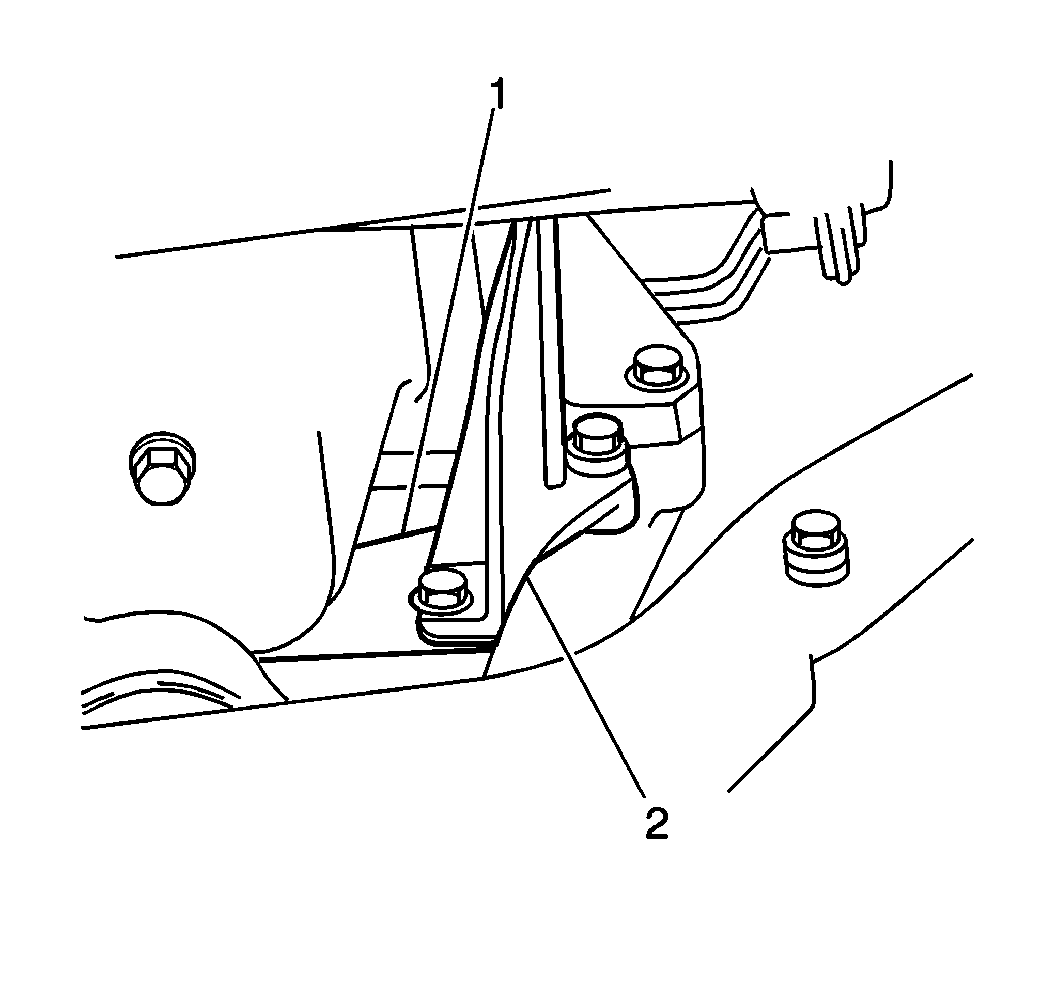Removal Procedure
- Raise and support the vehicle. Refer to Lifting and Jacking the Vehicle in General Information.
- Remove four bolts and the front skid plate from the vehicle (if equipped).
- Remove the front differential assembly from the chassis (four wheel drive vehicles). Refer to Differential Carrier Assembly Replacement in Front Drive Axle.
- Remove the crankshaft position sensor bolt.
- Remove the crankshaft position sensor.
- Place a drain pan beneath the engine oil pan to catch escaping oil.
- Remove the engine oil drain plug (2) and gasket allowing the engine oil to drain.
- Remove the transmission left side stiffener bracket (2).
- Remove the two bolts (four speed automatic transmission models).
- Remove the clutch housing lower plate (1) for manual transmission equipped vehicles. Refer to Manual Transmission.
- Remove the torque converter housing lower plate for automatic transmission equipped vehicles. Refer to Automatic Transmission.
- Remove the following from the cylinder block (1):
- Remove the two bolts and the oil pump strainer (3) from the cylinder block (1).
- Clean the inside of the engine oil pan (2) and oil pump strainer screen.
- Clean the mating surfaces of the engine oil pan (2) and the cylinder block (1).



| • | Sixteen bolts |
| • | Two nuts |
| • | The engine oil pan |
Installation Procedure
- Apply the silicone sealant GM P/N 12346240, or the equivalent, to the engine oil pan mating surface in a continuous bead (1).
- Install the oil pump strainer (3) to the cylinder block. Secure the oil pump strainer (3) with two bolts.
- Install the engine oil pan (2) to the cylinder block. Secure the engine oil pan (2) with sixteen bolts and two nuts.
- Install the clutch housing lower plate for the manual transmission equipped vehicles. Refer to Manual Transmission.
- Install the torque converter housing lower plate for the automatic transmission vehicles. Refer to Automatic Transmission.
- Install the left side stiffener bracket for the four speed transmission models. Secure the left side stiffener bracket with two bolts.
- Install the engine oil drain plug and gasket.
- Install the crankshaft position sensor.
- Install the front differential assembly to the chassis in four wheel drive vehicles. Refer to Manual Transmission.
- Install the front skid plate (if equipped). Secure the front skid plate with the four bolts.
- Lower the vehicle.
- Refill the engine oil according to the specifications. Refer to Approximate Fluid Capacities in Maintenance and Lubrication.
- Check the oil pressure upon completion of the installation. Refer to Oil Pressure Diagnosis and Testing .


Notice: Use the correct fastener in the correct location. Replacement fasteners must be the correct part number for that application. Fasteners requiring replacement or fasteners requiring the use of thread locking compound or sealant are identified in the service procedure. Do not use paints, lubricants, or corrosion inhibitors on fasteners or fastener joint surfaces unless specified. These coatings affect fastener torque and joint clamping force and may damage the fastener. Use the correct tightening sequence and specifications when installing fasteners in order to avoid damage to parts and systems.
Tighten
Tighten the oil pump strainer bolts to 11 N·m (97 lb in).
Tighten
Tighten the engine oil pan nuts and bolts to 11 N·m (97 lb in).
Tighten
Tighten the engine oil drain plug to 35 N·m (26 lb ft).
Tighten
Tighten the front skid plate and bolts to 55 N·m (40 lb ft).
